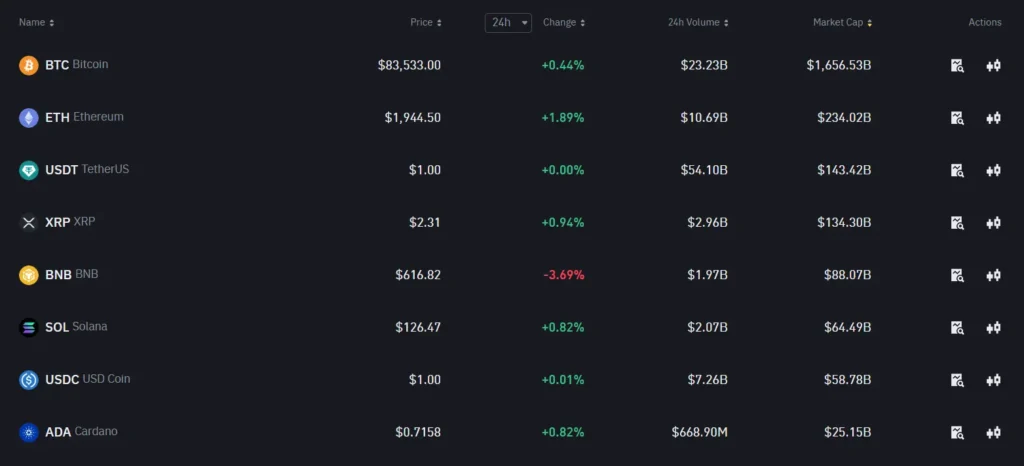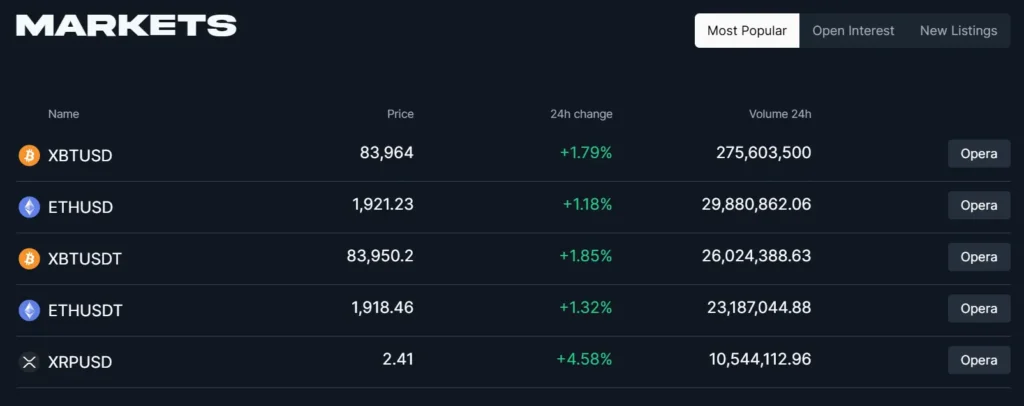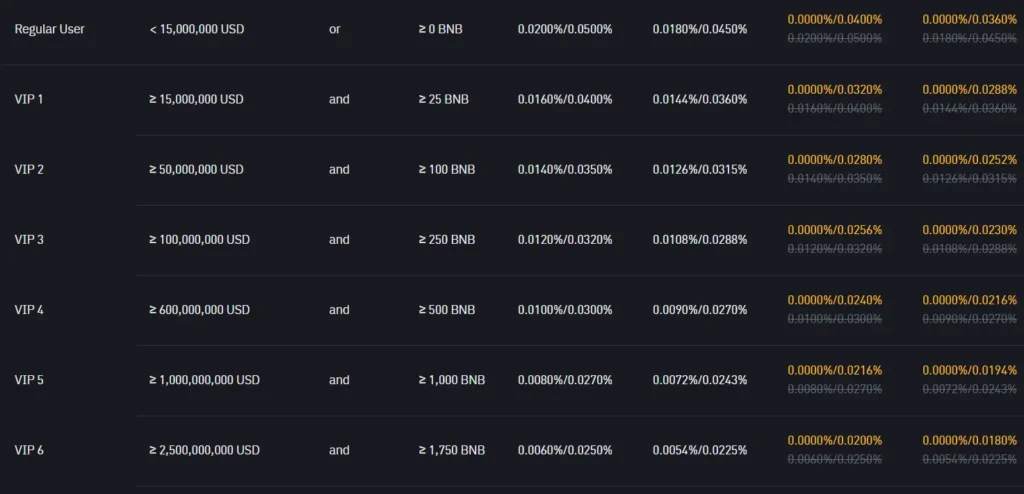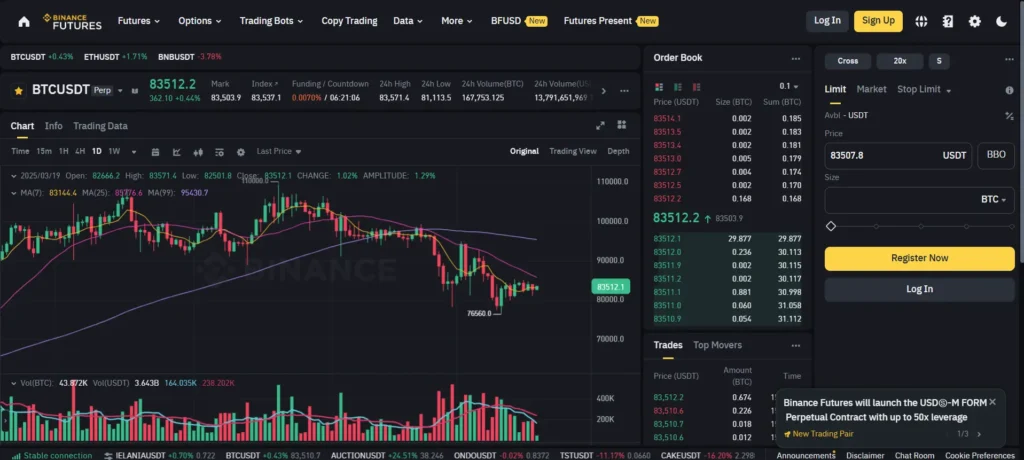If you’re looking to trade cryptocurrency, choosing the right exchange is crucial. Binance and BitMEX are two popular platforms with significant differences that affect your trading experience. Binance is generally better for beginners and offers a wider range of features, while BitMEX caters to experienced traders who understand margin trading.
These exchanges differ in key areas including user interface, security measures, and fee structures. Binance US has earned a higher overall score of 8.1 compared to BitMEX according to recent comparisons. This rating reflects Binance’s reputation for being easier to set up and use, making it accessible for traders at various experience levels.
Your trading goals will determine which platform serves you better. If you’re new to cryptocurrency trading, Binance’s intuitive interface and broader cryptocurrency selection might be the right fit. However, if you’re a veteran trader comfortable with complex trading strategies, BitMEX’s advanced features for margin trading could offer the tools you need.
Binance vs BitMEX: At A Glance Comparison
Binance and BitMEX are popular cryptocurrency exchanges with different strengths. Here’s a quick comparison to help you decide which platform might work better for your trading needs.
User Experience
Binance is generally considered more user-friendly and better for beginners. BitMEX has a steeper learning curve and is designed for experienced traders.
Trading Focus
Binance offers a wide range of cryptocurrencies and trading options. BitMEX specializes in crypto derivatives and margin trading.
Overall Ratings
Binance US has a higher overall score of 8.1 compared to BitMEX, according to BitDegree’s comparison.
Key Features Comparison
| Feature | Binance | BitMEX |
|---|---|---|
| User Level | Beginners to Advanced | Intermediate to Expert |
| Trading Types | Spot, Futures, Margin | Primarily Derivatives |
| Coin Selection | Extensive | Limited |
| Leverage Options | Up to 125x | Up to 100x |
| Interface | Clean, Intuitive | Complex, Data-heavy |
Binance might be your better choice if you’re new to crypto trading or want access to many different coins. The platform is easier to set up and use.
BitMEX could be more suitable if you’re an experienced trader interested in margin trading and derivatives. It offers sophisticated trading tools for veterans.
Business users and reviewers tend to prefer Binance for its overall experience and ease of administration.
Binance vs BitMEX: Trading Markets, Products & Leverage Offered
Binance offers a wider range of trading markets compared to BitMEX. While BitMEX focuses primarily on cryptocurrency derivatives, Binance provides both spot trading and futures options.
On Binance, you can trade hundreds of cryptocurrencies through spot markets. You’ll also find futures contracts, options, and leveraged tokens for many popular coins.
BitMEX specializes in derivatives trading with a focus on Bitcoin and other major cryptocurrencies. Their product selection is more limited but highly specialized for experienced traders.
When it comes to leverage, both exchanges offer significant options:
| Exchange | Maximum Leverage | Products Offered |
|---|---|---|
| Binance | Up to 125x | Spot, Futures, Options, Leveraged Tokens |
| BitMEX | Up to 100x | Perpetual Contracts, Futures |
BitMEX is known for its perpetual contracts which don’t have expiration dates. These are popular among traders who want long-term leveraged positions.
Binance’s ecosystem includes more diverse products like Dual Investment, Liquid Swap, and Savings options. This makes it a more comprehensive platform if you want variety.
For margin trading, both platforms allow you to borrow funds to increase your position size. However, Binance’s interface is generally considered more user-friendly for beginners.
Trading pairs on Binance include fiat-to-crypto options, while BitMEX focuses almost exclusively on crypto-to-crypto trading pairs.
Binance vs BitMEX: Supported Cryptocurrencies
When choosing between Binance and BitMEX, the variety of supported cryptocurrencies is an important factor to consider.

Binance offers a significantly larger selection of cryptocurrencies compared to BitMEX. You can trade hundreds of different crypto assets on Binance, making it a versatile platform for diversifying your portfolio.

BitMEX, on the other hand, supports a much more limited range of cryptocurrencies. It focuses primarily on Bitcoin and a select few altcoins, catering to traders who specialize in these specific markets.
If you’re looking to trade less common altcoins or newer tokens, Binance will likely be your better option. Its extensive list of supported cryptocurrencies allows you to explore emerging projects and different sectors of the crypto market.
BitMEX’s more focused approach works well if you’re mainly interested in trading Bitcoin derivatives with high leverage. The platform specializes in Bitcoin futures and perpetual contracts rather than offering a wide variety of coins.
Both exchanges continue to add new cryptocurrencies to their platforms, though Binance typically adds new tokens at a faster rate. This difference reflects their distinct business strategies – Binance aims to be comprehensive while BitMEX focuses on depth in fewer markets.
Your choice should depend on whether you prefer access to many different cryptocurrencies (Binance) or specialized trading tools for a smaller selection (BitMEX).
Binance vs BitMEX: Trading Fee & Deposit/Withdrawal Fee Compared

When choosing between Binance and BitMEX, understanding their fee structures can help you make a better decision. Both platforms offer competitive rates, but they differ in important ways.
Trading Fees
| Exchange | Trading Fees |
|---|---|
| Binance | Up to 0.1% |
| BitMEX | Up to 0.40% |
Binance clearly offers lower trading fees, making it more cost-effective for frequent traders. You can save up to 0.3% per trade compared to BitMEX, which adds up quickly if you trade often.
Withdrawal Fees
| Exchange | Withdrawal Fees |
|---|---|
| Binance | Up to $60 |
| BitMEX | 0.0001 BTC (fixed) |
BitMEX has a straightforward withdrawal fee structure with a fixed rate of 0.0001 BTC. This simplicity makes it easier to calculate your costs.

Binance’s withdrawal fees can go up to $60 depending on the cryptocurrency you’re withdrawing. This variable fee structure might be less favorable if you make frequent withdrawals.
It’s worth noting that BitMEX doesn’t charge any Bitcoin deposit fees. This feature can be attractive if you plan to make multiple deposits to your account.
Your trading volume and frequency will determine which platform offers the best value for you. High-volume traders might benefit more from Binance’s lower trading fees, while occasional traders might prefer BitMEX’s simple fee structure.
Binance vs BitMEX: Order Types
When trading on cryptocurrency exchanges, the types of orders you can place make a big difference in your trading strategy. Both Binance and BitMEX offer several order types, but they have some key differences.
Binance Order Types:
- Market orders
- Limit orders
- Stop-limit orders
- OCO (One-Cancels-the-Other)
- Trailing stop orders
- Post-only orders
Binance provides a good mix of basic and advanced order types. This makes it suitable for both beginners and experienced traders who want flexibility in their trading strategies.
BitMEX Order Types:
- Market orders
- Limit orders
- Stop orders
- Take-profit orders
- Hidden orders
- Iceberg orders
- Post-only orders
BitMEX is known for its advanced trading features. It offers specialized order types like iceberg orders that help you hide the true size of your position from other traders.
The main difference is that BitMEX focuses more on features for experienced margin traders. Its order system is designed for users who understand derivatives trading and want precise control.
Binance’s order system is more accessible to newer traders while still offering enough complexity for advanced strategies. You’ll find the interface more intuitive compared to BitMEX.
Both platforms support post-only orders which help you avoid paying maker fees, but BitMEX’s advanced order execution is particularly useful for high-frequency trading strategies.
Binance vs BitMEX: KYC Requirements & KYC Limits
Both Binance and BitMEX have Know Your Customer (KYC) requirements, but they differ in their approach and limits.
Binance KYC Requirements:
- Basic verification: Email and phone verification
- Intermediate: Government ID, facial verification
- Advanced: Proof of address, additional documentation
Binance offers higher thresholds for maximum deposit and withdrawal limits, especially for verified accounts. Unverified users face more restrictions on how much they can deposit or withdraw.
BitMEX KYC Requirements:
- Mandatory KYC for all users
- Photo ID verification
- Proof of residence
- Facial verification
BitMEX imposes stricter limits on transactions compared to Binance. These limits help maintain security but may restrict trading flexibility.
KYC Limits Comparison:
| Exchange | Unverified Limits | Fully Verified Limits |
|---|---|---|
| Binance | Low withdrawal limits | High deposit/withdrawal limits |
| BitMEX | No unverified access | Moderate to high limits |
The KYC process on both platforms helps protect your funds and ensures compliance with regulations. However, the verification time can vary between the two exchanges.
You’ll find Binance’s verification process typically faster and more streamlined than BitMEX’s. This can be important if you need quick access to higher withdrawal limits.
Binance vs BitMEX: Deposits & Withdrawal Options
When choosing a crypto exchange, understanding the deposit and withdrawal options is crucial for smooth transactions.
Binance offers a wide range of deposit methods. You can fund your account using cryptocurrencies, credit/debit cards, bank transfers, and various payment processors depending on your region.
BitMEX, on the other hand, only accepts cryptocurrency deposits. This limitation means you need to already own crypto or purchase it elsewhere before trading on BitMEX.
For withdrawals, both platforms support cryptocurrency options, but Binance provides more flexibility with fiat withdrawal methods in many regions.
Fee Comparison:
| Exchange | Withdrawal Fees | Speed |
|---|---|---|
| Binance | Up to 0.1% (varies by coin) | Usually within 1 hour |
| BitMEX | Fixed at 0.0001 BTC | Processing once daily |
Binance typically has more competitive withdrawal fees overall, with costs varying based on the specific cryptocurrency. BitMEX charges a fixed withdrawal fee regardless of the amount.
Processing time is another important factor. Binance processes most withdrawals quickly, often within an hour. BitMEX processes withdrawals only once per day, which might lead to longer waiting times.
For beginners, Binance’s multiple deposit options make it easier to start trading. BitMEX’s crypto-only approach is better suited for experienced traders who already have cryptocurrency holdings.
Binance vs BitMEX: Trading & Platform Experience Comparison
When choosing between Binance and BitMEX, the trading platform experience can make a big difference in your day-to-day activities.

Ease of Use
Binance offers a more user-friendly interface that works well for beginners and experienced traders alike. BitMEX has a steeper learning curve with its more technical layout that targets advanced traders.
Trading Features
- Binance: Spot trading, futures, options, margin trading up to 10x
- BitMEX: Primarily derivatives focused with up to 100x leverage on some contracts
Binance provides more variety in trading options while BitMEX specializes in cryptocurrency derivatives and high leverage trading.
Mobile Experience
Binance’s mobile app is highly rated and includes most features of the desktop version. BitMEX’s mobile platform is functional but not as comprehensive or user-friendly.
Trading Tools
Both platforms offer advanced charting tools, but Binance includes more built-in indicators and drawing tools. BitMEX provides detailed order books and position information that professional traders value.
Platform Stability
During high market volatility, Binance has shown better stability. BitMEX has faced criticism for system overloads during peak trading times.
User Interface Comparison
| Feature | Binance | BitMEX |
|---|---|---|
| Dashboard | Clean, customizable | Complex, data-heavy |
| Order Types | Multiple options | Advanced order types |
| Chart Tools | Comprehensive | Professional-grade |
| Navigation | Intuitive | Technical |
Your trading style and experience level should guide your choice between these platforms.
Binance vs BitMEX: Liquidation Mechanism
When trading with leverage on cryptocurrency exchanges, understanding the liquidation mechanism is crucial. Both Binance and BitMEX have systems in place to manage risk when trades move against you.
BitMEX uses a progressive liquidation system. When your position approaches the liquidation price, BitMEX’s system first tries to close your position at market price. If this fails, it uses the Insurance Fund to cover losses.
Binance employs a similar approach but with some key differences. Your positions on Binance go through a liquidation process that happens in stages to minimize market impact. The exchange also maintains an insurance fund to protect traders from excessive losses.
According to recent information, BitMEX has shown caution in how it handles liquidation orders. During a market event in March 2025, BitMEX carefully managed liquidations to avoid pushing prices down further, which helped stabilize the market.
The main difference lies in execution speed and transparency. Binance tends to provide more clear information about your liquidation price directly in the trading interface. This helps you better manage risk while trading.
Both platforms will notify you before liquidation occurs, but the warning thresholds differ. You should always set stop-loss orders to avoid reaching the liquidation point on either platform.
Remember to monitor your margin ratio carefully when trading on either exchange to avoid unexpected liquidations of your positions.
Binance vs BitMEX: Insurance
When trading cryptocurrency, insurance funds are important safety nets. They protect users from losses during extreme market volatility.
BitMEX has a stronger insurance position compared to Binance. According to search results, BitMEX’s insurance fund is approximately one-third the size of its open interest, giving it the largest ratio among crypto exchanges.
This larger insurance ratio means BitMEX may offer better protection against liquidations during market crashes. When prices move dramatically, this buffer helps prevent auto-deleveraging.
Binance also maintains an insurance fund, but it isn’t as proportionally large compared to its trading volume. However, Binance compensates with its larger user base of around 224 million users compared to BitMEX’s 100,000 active users.
Key Insurance Differences:
- BitMEX: Larger insurance-to-open-interest ratio
- Binance: Smaller proportional insurance fund but larger overall resources
When choosing between these platforms, consider your risk tolerance. If you’re concerned about protection during extreme volatility, BitMEX’s insurance structure might give you more peace of mind.
Remember that insurance funds don’t guarantee you’ll never lose money. They simply reduce the chance of catastrophic losses during unusual market conditions.
Binance vs BitMEX: Customer Support
When choosing a cryptocurrency exchange, customer support quality can make a big difference in your trading experience. Binance and BitMEX offer different levels of support for their users.
Binance provides more comprehensive customer support compared to BitMEX. They offer multiple support channels including live chat, email tickets, and an extensive help center with guides and FAQs.
BitMEX’s support system is more limited, primarily relying on email-based ticket systems. Response times can vary between the two platforms.
Binance supports more languages for their customer service team, making it accessible to a global audience. This multilingual approach helps users from different regions get assistance in their preferred language.
Response time is another important factor. Binance typically offers faster response times, especially through their live chat option which can connect you with support agents quickly for urgent issues.
Both exchanges provide knowledge bases, but Binance’s documentation is generally more comprehensive and beginner-friendly. Their tutorials cover a wider range of topics and are regularly updated.
For new crypto traders, Binance’s more robust support system may be preferable. Experienced traders who rarely need assistance might find either platform suitable for their needs.
Binance vs BitMEX: Security Features
When trading cryptocurrency, security should be your top priority. Both Binance and BitMEX implement strong security measures, but they differ in several important ways.
Binance offers two-factor authentication (2FA) through Google Authenticator or SMS verification. You can also set up address whitelisting to ensure withdrawals only go to approved addresses.
BitMEX also provides 2FA protection but adds multi-signature wallet technology for an extra layer of security. This means multiple approvals are needed before funds can be moved.
Key Security Features Comparison:
| Feature | Binance | BitMEX |
|---|---|---|
| Two-Factor Authentication | ✓ | ✓ |
| Anti-Phishing Code | ✓ | ✗ |
| Multi-Signature Wallets | ✗ | ✓ |
| Address Whitelisting | ✓ | ✓ |
| Cold Storage | 90% of funds | Most funds |
| Insurance Fund | Limited | Substantial |
Binance stores about 90% of user funds in cold storage, keeping them offline and safe from hackers. Their SAFU (Secure Asset Fund for Users) offers some protection against breaches.
BitMEX maintains most customer funds in cold storage as well. They’ve built a substantial insurance fund over time to protect against system failures or liquidation issues.
Both exchanges run regular security audits but have experienced incidents in the past. Binance had a significant hack in 2019, while BitMEX has faced DDoS attacks.
You should enable all available security features regardless of which platform you choose. Using unique passwords and hardware wallets for long-term storage adds extra protection to your crypto assets.
Is Binance Safe & Legal To Use?
Binance has established itself as one of the largest cryptocurrency exchanges in the world. When it comes to safety, Binance implements strong security measures including two-factor authentication (2FA) and cold storage for most funds.
The exchange uses a Secure Asset Fund for Users (SAFU), which is an emergency insurance fund. This fund helps protect user assets in extreme cases.
Legal status varies by country:
- Legal in most countries worldwide
- Restricted in the United States (use Binance.US instead)
- Banned or restricted in countries like China and India
You should always verify Binance’s legal status in your specific location before signing up. Regulations change frequently in the crypto space.
Despite good security, no exchange is 100% safe. It’s best practice not to store large amounts of cryptocurrency on any exchange long-term. Consider using hardware wallets for significant holdings.
Binance requires KYC (Know Your Customer) verification for most services. This helps with security but requires sharing personal information.
The platform regularly undergoes security audits and has a good track record of addressing vulnerabilities. However, like any exchange, it remains a target for hackers.
Is BitMEX Safe & Legal To Use?
BitMEX operates with strong security measures to protect user funds and data. The platform uses multi-signature wallets and cold storage for most crypto assets, reducing vulnerability to hacks.
Regarding legality, BitMEX is registered in Seychelles and follows regulations in various jurisdictions. However, availability varies by country, and you should check if it’s permitted in your location.
BitMEX has faced regulatory challenges in the past. In 2020, the exchange had issues with US regulators, resulting in restrictions for American traders.
The platform requires KYC (Know Your Customer) verification to comply with anti-money laundering regulations. You’ll need to submit identification documents before trading.
BitMEX has implemented two-factor authentication (2FA) to add an extra layer of security to your account. This feature is strongly recommended to protect your funds.
For added protection, you can set up IP address whitelisting. This restricts account access to specific IP addresses that you approve.
Important Security Features:
- Multi-signature wallets
- Cold storage for funds
- Two-factor authentication
- IP whitelisting
- Insurance fund for contract settlements
While BitMEX has solid security, you should always practice safe trading habits. Use strong passwords, enable all security features, and never share access information.
Frequently Asked Questions
Traders considering Binance and BitMEX often have specific concerns about features, security, and accessibility. These exchanges differ significantly in several important areas that can impact your trading experience.
What are the key differences in trading features between Binance and BitMEX?
Binance offers a wider range of trading options suitable for both beginners and advanced traders. You can access spot trading, futures, options, and margin trading all in one platform.
BitMEX focuses primarily on derivatives trading with high leverage options up to 100x. It caters more to experienced traders who understand margin trading and advanced trading strategies.
Binance’s interface is generally considered more user-friendly, making it easier to navigate for newcomers. BitMEX’s platform has more complex features that veterans appreciate but might overwhelm beginners.
How do the security measures on Binance compare to those on BitMEX?
Both exchanges implement robust security protocols. Binance offers two-factor authentication, address whitelisting, and maintains a Secure Asset Fund for Users (SAFU) to protect against potential hacks.
BitMEX also uses two-factor authentication and cold storage for funds. Their multi-signature withdrawal scheme adds an extra layer of security for your assets.
Binance has faced security breaches in the past but has compensated affected users. BitMEX has maintained a relatively strong security record throughout its operation.
Can users from the United States trade on Binance or BitMEX?
U.S. traders cannot use the main Binance.com platform but can access Binance US, a separate platform with fewer trading options and cryptocurrencies.
BitMEX does not allow U.S. residents to trade on their platform at all due to regulatory constraints. They actively block U.S. IP addresses and require identity verification.
Attempting to circumvent these restrictions violates the terms of service and may result in account closure and potential loss of funds.
What are the fee structures for Binance and BitMEX, and how do they impact traders?
Binance typically charges lower trading fees, starting at 0.1% for spot trading with discounts available when using BNB token. Futures fees are even lower at 0.02% to 0.04%.
BitMEX has a maker-taker fee model where makers can receive rebates of 0.025% while takers pay 0.075% for most contracts. This encourages providing liquidity.
For frequent traders, these fee differences can significantly impact profitability over time. Binance’s overall lower fee structure benefits casual traders more.
How does the liquidity and volume on Binance contrast with BitMEX?
Binance consistently maintains higher trading volumes and liquidity across most trading pairs. This means you’ll experience less slippage and easier execution of large orders.
BitMEX has strong liquidity specifically for Bitcoin derivatives but falls behind Binance in overall market depth and trading volume for other cryptocurrencies.
Higher liquidity on Binance means price stability during volatile market conditions. You’re less likely to experience significant price deviations when executing trades.
What variety of cryptocurrencies can be traded on Binance versus BitMEX?
Binance supports hundreds of cryptocurrencies and thousands of trading pairs. You can trade everything from major coins to small-cap altcoins and new token listings.
BitMEX focuses primarily on Bitcoin and a limited selection of major altcoins like Ethereum and Ripple. Their emphasis is on quality over quantity of trading pairs.
If you’re looking to diversify your crypto portfolio widely, Binance offers significantly more options. BitMEX is more suitable if you primarily trade Bitcoin derivatives with leverage.
BitMEX vs Binance Conclusion: Why Not Use Both?
After comparing these two popular cryptocurrency exchanges, you might be wondering which one to choose. The answer could be both.
BitMEX shines for experienced traders who understand margin trading. It offers advanced trading features but has a steeper learning curve.
Binance works well for both beginners and advanced users. It provides a smoother user experience and more intuitive interface.
Using both platforms gives you access to different benefits. When you need simplicity and a wide variety of coins, Binance is your go-to option.
For leverage trading and more complex strategies, BitMEX could be your platform of choice.
Consider your trading needs carefully:
- For beginners: Start with Binance
- For advanced traders: You might benefit from both
- For margin trading: BitMEX offers specialized tools
Your trading experience and goals should guide your decision. Many traders maintain accounts on multiple exchanges to take advantage of different features and opportunities.
Security is important on both platforms, so always use strong passwords and two-factor authentication regardless of which exchange you choose.
Remember that fees differ between the platforms, so factor this into your trading strategy. Using both gives you flexibility to choose the most cost-effective option for each trade.
